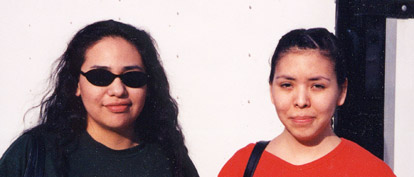Indians aren't supposed to be modern
No One Ever Sees Indians: “On Stealing a Native Identity”[W]hen we screened Chris Eyre’s A Thousand Roads, there is a segment about a young Inupiat girl returning to Baro, Alaska to live with relatives she has just met while her mother serves overseas. I noticed the same reaction every time one particular scene comes on screen. The scene shows the girl’s cousins playing a Star Wars video game and every time the movie showed the kids playing the game, with the too-familiar music and light-saber sound effects, there was an audible chuckle that roiled through the audience.
Indian kids are not supposed to play video games, or watch standard Hollywood fare, read comic books, or watch too much television. They are not supposed to think that every kid in America grows up in the splendor that they do. To believe they are no different from the kids they see on TV and in movies. Indians are supposed to be mystical, and mythical, and at the same time violent and warlike and unable to grasp modern technology, such as making movies about their lives. That is the perception we have had to endure for so long.


2 comments:
Some reservations still don't have electricity. According to recent reports, the Navajo are just beginning to provide Internet access across their sprawling reservation. And you noted that Oklahoma schools wouldn't have provided computer courses to Indians without your intervention.
Moreover, access to technology is only one aspect of "being modern" in Whiteman's article. He also mentions access to books, comic books, and movies. How close do you think the nearest comic-book shop or movie theater is on the Navajo rez, in Montana, or in Alaska, hmm?
Access to media in general is still only one aspect of Whiteman's argument. He's talking about access to all areas of mainstream American life: malls, nightclubs, amusement parks, office-supply stores, art schools, ethnic restaurants, sci-fi conventions, etc. How many of these things do you think you'll find on the typical reservation? How much farther does the average Native have to go to encounter these things?
Besides, Whiteman's point is mainly about perceptions. Even if Natives had perfect access to everything--which they don't--non-Natives still would perceive them as mystical or warlike. Why? Because non-Natives "know" Natives via stereotypes in the media, not in reality.
Conclusion: Whiteman's argument is sound. Whatever your hometown situation is, it's only one piece of anecdotal evidence. It doesn't necessarily tell us what most (non-urban) Natives experience. And it definitely doesn't tell us how most Americans perceive Natives.
I liked Indian "everyday life" being shown but hated the "A 1000 Roads" film overall, it was despressing and ended up created this "save the poor lonely Indians" image. For my film music review, go to http://www.filmcomposer.us/nmai.html
Brent
Post a Comment